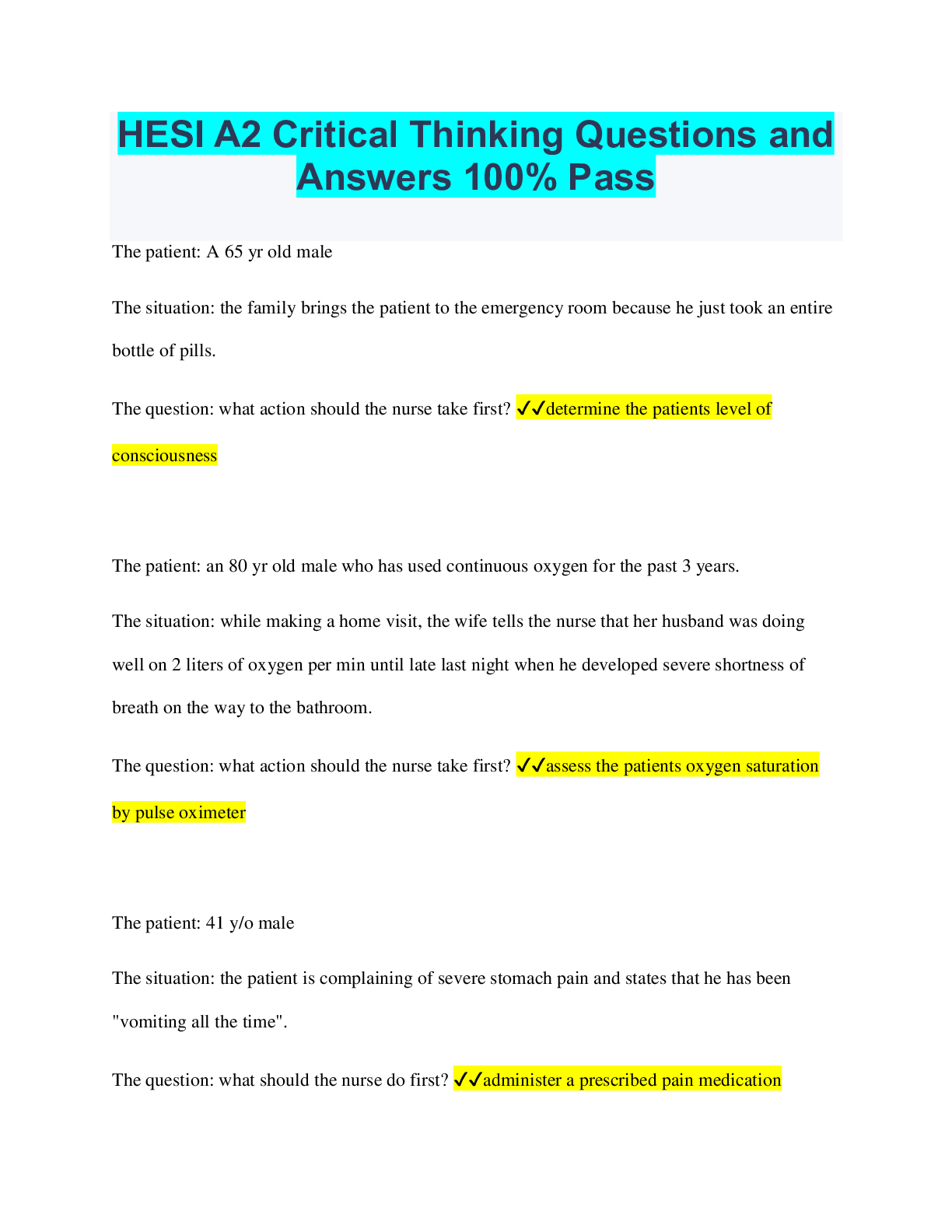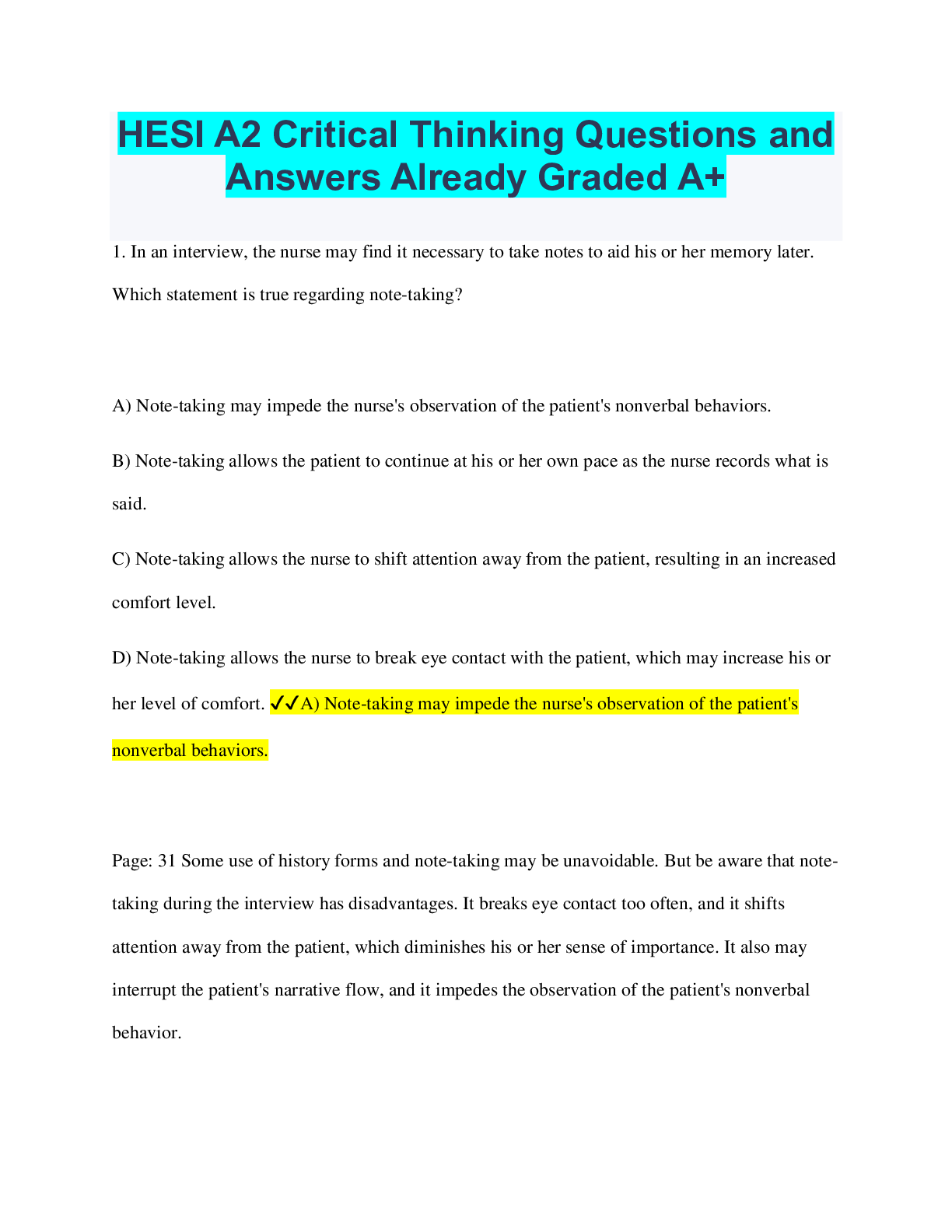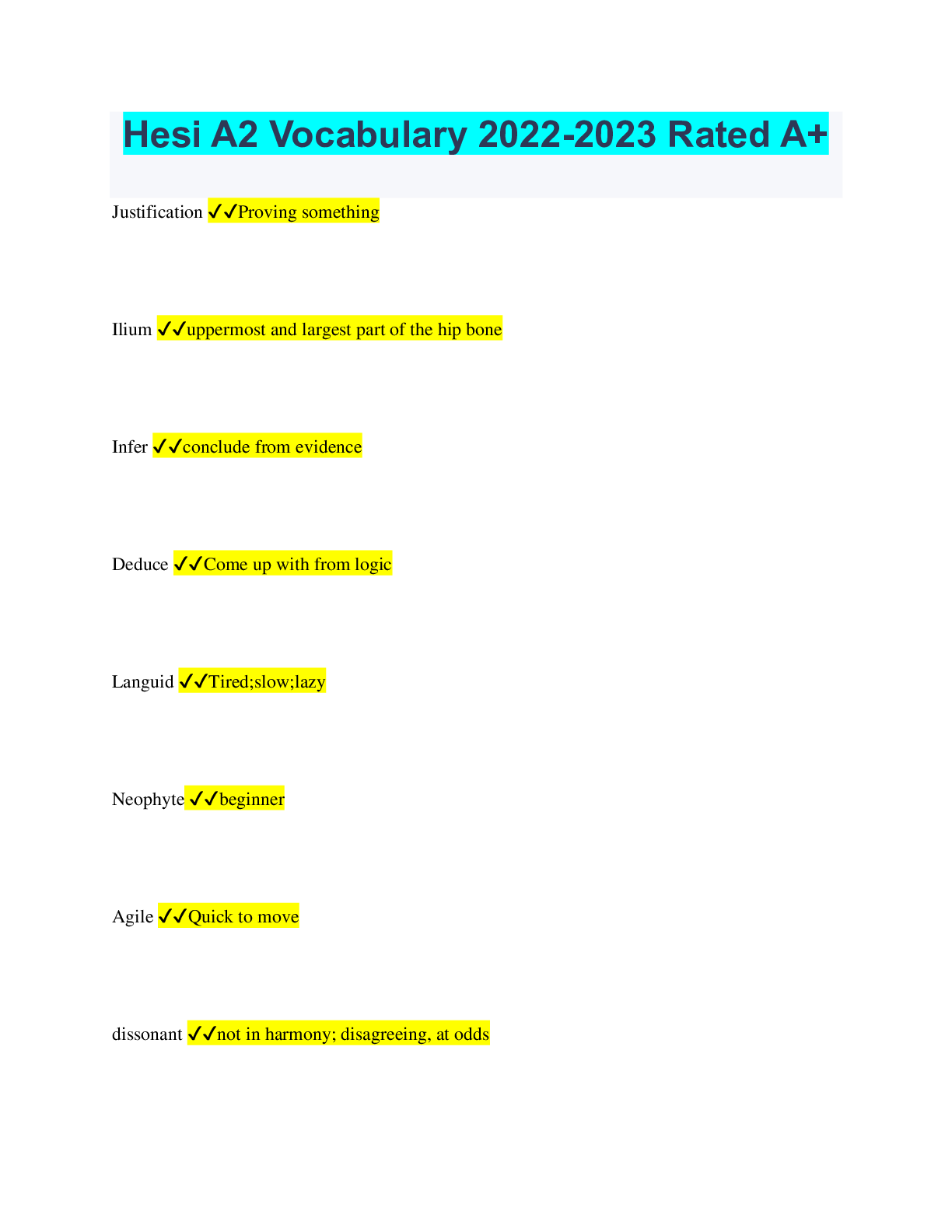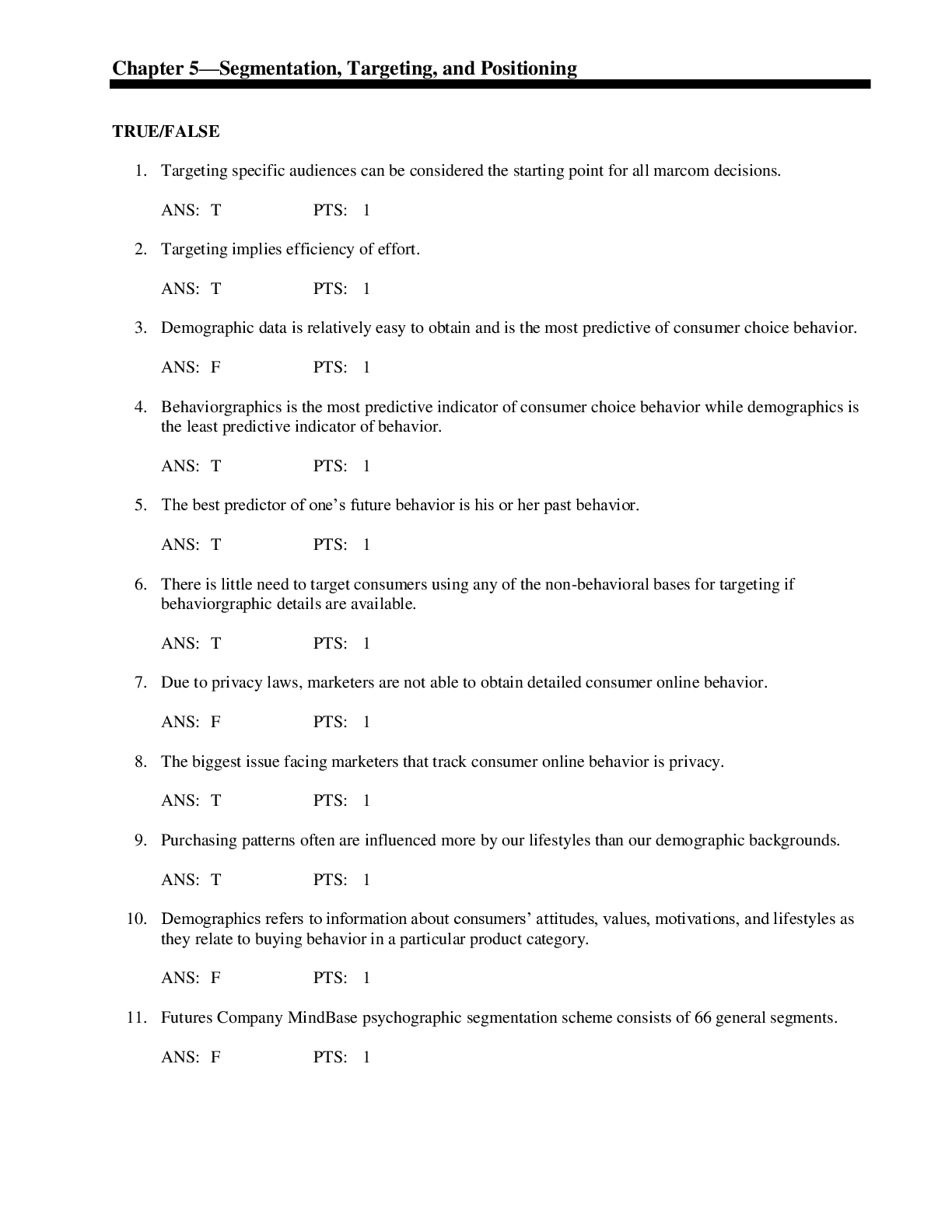Education > QUESTIONS & ANSWERS > STR Test Questions and Answers with Complete Solutions (All)
STR Test Questions and Answers with Complete Solutions
Document Content and Description Below
STR Test Questions and Answers with Complete Solutions An English language learner regularly skips or misreads high-frequency prepositions while reading connected texts. In order to best help this ... student develop accuracy and automaticity, the teacher should: ✔✔provide practice readings that use the high-frequency prepositions and that include illustrations of the preposition in action. A first-grade teacher plans her reading lessons so that they always include time for the teacher to read at least part of the text aloud to students. What is one way in which teacher-modeled reading can benefit students' fluency skills? ✔✔Listening to the teacher read will help students learn to develop prosody in their own reading. A pre-K teacher has children participate in the following activities: clapping syllables in students' names counting syllables in days of the week standing up if their names contain a specific number of syllables These types of activities help students to: ✔✔develop phonological awareness by using meaningful words. A second-grade teacher would like to help students develop their phonological awareness skills by teaching them to decode words faster as they read. Which of the following concepts should the teacher focus on to help students achieve this goal? ✔✔how to separate words into syllables A third-grade class has been studying mammals and reptiles, and the teacher would like to help students synthesize all the information they have learned about both types of animals. The teacher seats students in pairs and asks them to fill in a blank Venn diagram. Next, the teacher conducts a class discussion in which each pair of students shares their organizer and she records their findings in a whole-group version, shown here: (Venn Diagram) The teacher distributes another blank copy of the organizer to each student, along with two articles to read, one on amphibians and one on crustaceans. Using this organizer could help students retain the new information they learn by: ✔✔providing a system for recording commonalities and differences between the topics. A third-grade class has been studying mammals and reptiles, and the teacher would like to help students synthesize all the information they have learned about both types of animals. The teacher seats students in pairs and asks them to fill in a blank Venn diagram. Next, the teacher conducts a class discussion in which each pair of students shares their organizer and she records their findings in a whole-group version, shown here: (Venn Diagram) Creating this type of graphic organizer will help students develop their reading comprehension skills by: ✔✔showing them how to compare and contrast differences and similarities. A first-grade student is reading aloud and mispronounces the following words: after, old, ask, and what. The student could benefit from additional instruction in which of the following areas? ✔✔automatic recognition of high-frequency words A class of first-grade students has been learning how to decode words. Which of the following lessons would be the best way to teach them to decode words ending in the inflectional morpheme -ed? ✔✔teaching students to read the -ed by itself and then decode the front of the word before the inflection before adding them together A first-grade teacher has recently conducted oral timed reading assessments. She records the number of words per minute a student completes as well as any miscues and self-corrections made by the student. The teacher meets privately with each student to share the results. The teacher meets with Tim first. She noted in Tim's reading that he made a number of miscues but did not pause to acknowledge them or attempt to self-correct. Tim read at an above-average speed, completing the reading 20 seconds faster than his peers. Some of his errors included saying "dark" for "bark," "nap" for "map," and "jab" for "gab." Previously Tim has been able to read grade-level texts with 95% accuracy, but on this assessment he scored closer to 75%. During the conference, the teacher should be sure to: ✔✔tell the student the ways in which he read well as well as provide actionable areas of improvement. A first-grade teacher has recently conducted oral timed reading assessments. She records the number of words per minute a student completes as well as any miscues and self-corrections made by the student. The teacher meets privately with each student to share the results. The teacher meets with Tim first. She noted in Tim's reading that he made a number of miscues but did not pause to acknowledge them or attempt to self-correct. Tim read at an above-average speed, completing the reading 20 seconds faster than his peers. Some of his errors included saying "dark" for "bark," "nap" for "map," and "jab" for "gab." Previously Tim has been able to read grade-level texts with 95% accuracy, but on this assessment he scored closer to 75%. Based on the results of the assessment, which activity would best address the errors made by Tim and improve his oral reading in the future? ✔✔modelling reading with appropriate speed and having Tim practice reading more slowly and with expression When working with English language learners on phonemic awareness and phoneme identification, it is most appropriate to select words that: ✔✔include sounds used in both English and the student's native language. A small group of first-grade students are in the pre-alphabetic stage of reading development. In order to remediate these students and move them into the partial alphabetic stage, the teacher should provide instruction on: ✔✔letter-sound correspondence and letter names. A kindergarten teacher is working with a small group of Chinese-speaking English language learners who have just moved to the school district. The students are confident readers when the text is written in Chinese but they struggle when presented with a text in English. In order to ease the transition to English written texts, the teacher should begin with a basic lesson on: ✔✔English print concepts such as left-to-right, top-to-bottom print directionality. A teacher is reading aloud to the class from a retelling of "Jack and the Beanstalk," and during the reading she pauses to th [Show More]
Last updated: 2 years ago
Preview 1 out of 27 pages
.png)
Buy this document to get the full access instantly
Instant Download Access after purchase
Buy NowInstant download
We Accept:

Also available in bundle (1)
.png)
STR BUNDLED EXAMS QUESTIONS AND ANSWERS WITH COMPLETE SOLUTIONS (LATEST 2022)
STR BUNDLED EXAMS QUESTIONS AND ANSWERS WITH COMPLETE SOLUTIONS (LATEST 2022)
By Nutmegs 2 years ago
$16
12
Reviews( 0 )
$10.00
Can't find what you want? Try our AI powered Search
Document information
Connected school, study & course
About the document
Uploaded On
Oct 29, 2022
Number of pages
27
Written in
Additional information
This document has been written for:
Uploaded
Oct 29, 2022
Downloads
0
Views
116


























